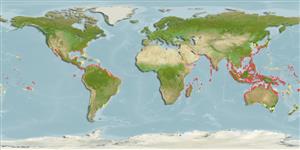Common names from other countries
Classification / Names / Names
俗名 | 同種異名 | Catalog of Fishes (gen., sp.) | ITIS | CoL | WoRMS
Environment: milieu / climate zone / depth range / distribution range
生態學
.
分布
國家 | FAO區域 | 生態系 | 發現紀錄 | 簡介
Atlantic Ocean: in the Caribbean (in Lesser Antilles). Indian Ocean: from Djibouti to South Africa, including Reunion, east to India and south to Western Australia, including Andaman and Nicobar Islands. Pacific Ocean: from China to the South China Sea south to Queensland Australia, including Lord Howe Island and Fiji, east to the Hawaiian Islands.
Length at first maturity / 大小 / 重量 / 年齡
Maturity: Lm ? range ? - ? cm
Thalli consist of many terete branches, tapering to acute tips, densely covered with 1 to 8 mm long spinose determinate branchlets arranged in whorls, forming distinct nodes and internodes at the distal portions of the branches. Cross-section of a branch reveals a dense core of thick-walled and very small rhizoidal cells. Thalli up to 30 cm in height (Ref. 80758). The fusion of branches upon coming in contact with each other and their ability to form secondary holdfasts at tips of branches results in the formation of thick and strongly attached clumps or carpet-like beds (Ref. 80758).
Used for human consumption in stews, eaten fresh, or blanched in boiling water, or made into Eucheuma candy, or as garnishing; principal source of phycocolloid carrageenan (iota); controls heavy metal pollution (Pb, Cd); used as manure in industrial products and processes; used in animal feeds (Ref. 80758).
主要參考資料
參考文獻 | 合作者 | 合作者
Guiry, M.D. and G.M. Guiry. 2009. (Ref. 80701)
IUCN 瀕危狀態 (Ref. 130435: Version 2024-1)
CITES狀態 (Ref. 108899)
Not Evaluated
Not Evaluated
對人類具威脅
人類使用
漁業: 商業性
FAO - 養殖: 產生; | FishSource |
工具
更多資訊
年龄/大小成長長度-重量長度-長度型態特徵仔魚豐度
網路資源
Estimates based on models
Preferred temperature
(Ref.
115969): 24.7 - 29.3, mean 28.2 (based on 3630 cells).
